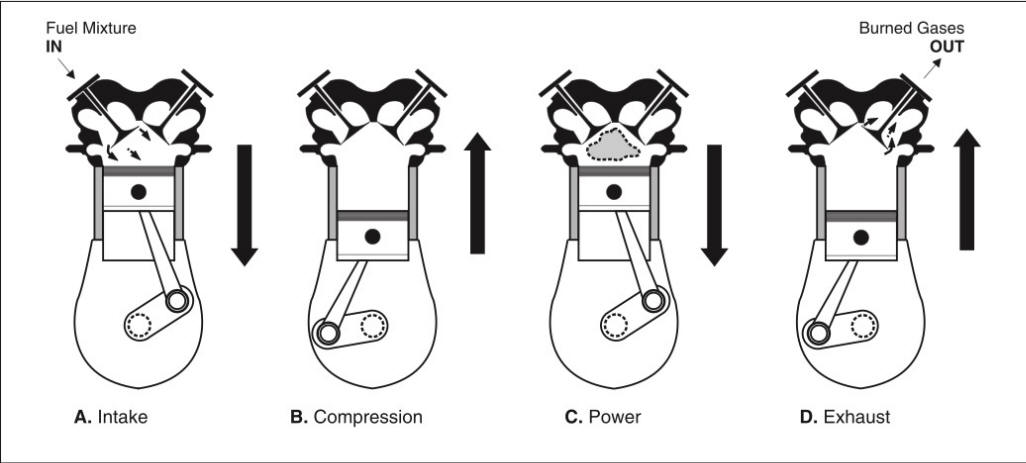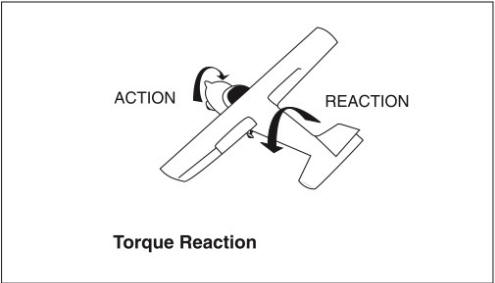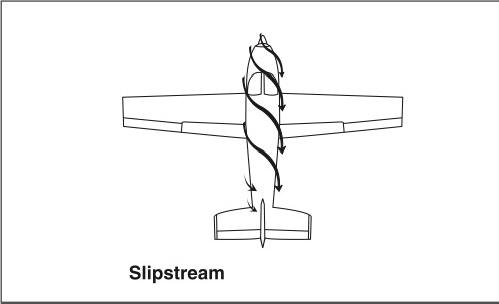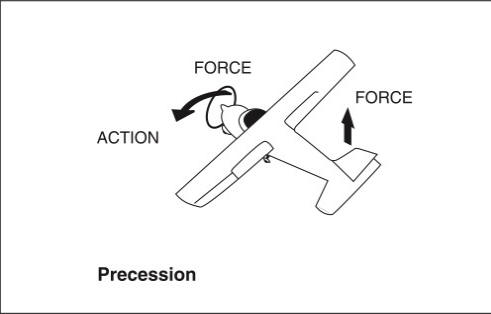|
Aircraft
and Human Performance |
Aircraft Systems
|
| Basic
Aerodynamics |
Communication Procedures |
Enroute Flight |
|
Flight Instruments
|
Navigation |
Procedures and Airport Operations |
| Regulations | Weather | Weather Services | First Aid & Physiology |
Aircraft Systems
Table of Contents
Reciprocating EnginesIgnition and Electrical Systems
Fuel Induction Systems
Carburetor Ice
Aviation Fuel
Engine Temperatures
Propellers
Torque
Preflight Inspection Procedures
Reciprocating Engines
The first action after starting an aircraft engine should be adjust
for proper RPM and check for desired indications on the engine gauges. Adjust
for proper RPM and check for desired indications on the engine gauges.
One procedure to aid in cooling an engine that is overheating is to
enrichen the fuel mixture.
A precaution for the operation of an engine equipped with a constant-speed
propeller is to avoid high manifold pressure settings with low RPM. avoid
high manifold pressure settings with low RPM.
The presence of carburetor ice in an aircraft equipped with a fixed-pitch
propeller can be verified by applying carburetor heat and noting a decrease in
RPM and then a gradual increase in RPM. a decrease in RPM and then a gradual
increase in RPM.
On aircraft equipped with fuel pumps, the auxiliary electric driven pump used
in the event engine driven fuel pump fails.
The condition most favorable to the development of carburetor icing is
temperatures between 20 and 70 °F and high humidity.
Applying carburetor heat will enrich the fuel/air mixture.
While cruising at 9,500 feet MSL, the fuel/air mixture is properly adjusted. If
a descent to 4,500 feet MSL is made without readjusting the mixture, the
fuel/air mixture may become excessively lean.
Excessively high engine temperatures, either in the air or on the ground, will
cause loss of power, excessive oil consumption, and possible permanent
internal engine damage.
If the static vents become clogged the Airspeed, Altimeter, and Vertical
Speed instruments will become inoperative.
Should it become necessary to handprop an airplane engine, it is extremely
important that a competent pilot be at the controls in the cockpit.
The four flight fundamentals involved in maneuvering an aircraft are:
Straight and level flight, turns, climbs, and descents.
Most small airplanes are powered by reciprocating engines made up, in part, of cylinders, pistons, connecting rods, and a crankshaft. The pistons move back and forth within the cylinders. Connecting rods connect the pistons to the crankshaft, which converts the back and forth movements of the pistons to a rotary motion. It is this rotary motion which drives the propeller.
One cycle of the engine consists of two revolutions of the crankshaft. These two crankshaft revolutions require four strokes of the piston; namely, the intake, compression, power, and exhaust strokes.
The top end of the cylinder houses an intake valve, an exhaust valve, and two spark plugs.
During the intake stroke, the intake valve is open and the piston moves away from the top of the cylinder and draws in a fuel/air mixture (Figure 2-1A).
At the completion of the intake stroke, the intake valve closes and the piston returns to the top of the cylinder and compresses the fuel/air mixture (Figure 2-1B).
When the piston reaches a precise point near the top of its stroke, the spark plugs ignite the compressed mixture and the rapid expansion of the burning mixture forces the piston downward (Figure 2-1C).
As the piston completes the downward movement of the power stroke, the exhaust valve opens and the piston rises to the top of the cylinder. This exhaust stroke forces out the burned gases and completes one cycle of the engine (Figure 2-1D).

Because of the many moving parts in a reciprocating engine, as soon as the engine is started, power should be set to the RPM recommended for engine warm-up and the engine gauges checked for the desired indications.
Should it be necessary to start the engine by hand propping, it is extremely important that a competent pilot be at the controls in the cockpit. In addition, the person turning the propeller should be thoroughly familiar with the procedure.
Ignition and Electrical Systems
Most reciprocating engines used to power small aircraft incorporate two separate magneto ignition systems.
A magneto (“mag”) is a self-contained source of electrical energy, so even if an aircraft loses total electrical power, the engine will continue to run.
When checking for magneto operation prior to flight, the engine should run smoothly when operating with the magneto selector set on “BOTH,” and should experience a slight drop in revolutions per minute (RPM) when running on only one or the other magneto.
The main advantages of the dual ignition system are increased safety and improved engine performance.
Fuel Induction Systems
Most light airplane engines use either a carburetor or a fuel injection system to deliver a fuel/air mixture to the cylinders.
In a carburetor induction system, the float-type carburetor takes in air that flows through a restriction (venturi), which creates a low-pressure area. The pressure difference between the low-pressure area and outside air forces fuel into the airstream where it is mixed with the flowing air, drawn through an intake manifold, and delivered to the combustion chambers and ignited.
Carburetors are normally set to deliver the correct fuel/air mixture at sea level. Since air density decreases with altitude, a mixture control allows the pilot to decrease the fuel flow as altitude increases and thus maintain the correct mixture. Otherwise the mixture may become too “rich” at high altitudes.
When descending, air density increases. Unless fuel flow is increased, the mixture may become excessively “lean,” i.e., the amount of fuel is too small for the amount of air reaching the cylinders. Modern four-stroke engines may automatically adjust the mixture control. Two-stroke engines typically require main jet changes for operations at different altitudes.
In a fuel injection system the fuel and air are mixed just prior to entering the combustion chamber. No carburetor is used.
Carburetor Ice
As air flows through a carburetor it expands rapidly. At the same time, fuel forced into the airstream is vaporized. Expansion of the air and vaporization of the fuel causes a sudden cooling of the mixture which may cause ice to form inside the carburetor. The possibility of icing should always be considered when operating in conditions where the temperature is between 20°F and 70°F, and the relative humidity is high.
Carburetor heat preheats the air before it enters the carburetor and either prevents carburetor ice from forming or melts any ice which may have formed. When carburetor heat is applied, the heated air that enters the carburetor is less dense. This causes the fuel/air mixture to become enriched, and this in turn decreases engine output and increases engine operating temperatures.
During engine runup prior to departure from a high-altitude airport, the pilot may notice a slight engine roughness which is not affected by the magneto check, but grows worse during the carburetor heat check. In this case, the fuel/air mixture may be too rich due to the lower air density at the high altitude, and applying carburetor heat decreases the air density even more. A leaner setting of the mixture control may correct this problem.
In an airplane with a fixed-pitch propeller, the first indication of carburetor ice would likely be a decrease in RPM as the air supply is choked off. Application of carburetor heat will decrease air density, causing the RPM to drop even lower. Then, as the carburetor ice melts, the RPM will rise gradually.
Fuel injection systems do not utilize a carburetor and are generally considered to be less susceptible to icing than carburetor systems are.
Aviation Fuel
Fuel does two things for the engine; it acts both as an agent for combustion and as an agent for cooling (based on the mixture setting of the engine).
Aviation fuel is available in several grades. The proper grade for a specific engine will be listed in the aircraft flight manual. If the proper grade of fuel is not available, it is possible to use the next higher grade. A lower grade of fuel should never be used.
The use of low-grade fuel or a fuel/air mixture which is too lean may cause detonation, which is the uncontrolled spontaneous explosion of the mixture in the cylinder. Detonation produces extreme heat.
Preignition is the premature burning of the fuel/air mixture. It is caused by an incandescent area (such as a carbon or lead deposit heated to a red hot glow) which serves as an ignitor in advance of normal ignition.
Fuel can be contaminated by water and/or dirt. The air inside the aircraft fuel tanks can cool at night, and this cooling forms water droplets (through condensation) on the insides of the fuel tanks. These droplets then fall into the fuel. To avoid this problem, always fill the tanks completely when parking overnight.
Thoroughly drain all of the aircraft’s sumps, drains, and strainers before a flight to get rid of all the water that might have collected.
Dirt can get into the fuel if refueling equipment is poorly maintained or if the refueling operation is sloppy. Use care when refueling an aircraft.
Two fuel pump systems are used on most airplanes. The main pump system is engine driven and an auxiliary electric driven pump is provided for use in the event the engine pump fails. The auxiliary pump, commonly known as the boost pump, provides added reliability to the fuel system, and is also used as an aid in engine starting. The electric auxiliary pump is controlled by a switch in the cockpit.
Engine Temperatures
Engine lubricating oil not only prevents direct metal-to-metal contact of moving parts, it also absorbs and dissipates some of the engine heat produced by internal combustion. If the engine oil level should fall too low, an abnormally high engine oil temperature indication may result.
On the ground or in the air, excessively high engine temperatures can cause excessive oil consumption, loss of power, and possible permanent internal engine damage.
If the engine oil temperature and cylinder head temperature gauges have exceeded their normal operating range, or if the pilot suspects that the engine (with a fixed-pitch propeller) is detonating during climb-out, the pilot may have been operating with either too much power and the mixture set too lean, using fuel of too low a grade, or operating the engine with an insufficient amount of oil in it. Reducing the rate of climb and increasing airspeed, enriching the fuel mixture, or retarding the throttle will aid in cooling an engine that is overheating.
The most important rule to remember in the event of a power failure after becoming airborne is to maintain safe airspeed.
Propellers
A propeller provides thrust to propel the airplane through the air. Some aircraft are equipped with a constant-speed propeller. This type of propeller allows the pilot to select the most efficient propeller blade angle for each phase of flight. In these aircraft, the throttle controls the power output as registered on the manifold pressure gauge, and the propeller control regulates the engine RPM.
A pilot should avoid a high manifold pressure setting with low RPM on engines equipped with a constant-speed propeller. To avoid high manifold pressure combined with low RPM, reduce the manifold pressure before reducing RPM when decreasing power settings (or increase the RPM before increasing the manifold pressure when increasing power settings).
Torque
An airplane of standard configuration has an insistent tendency to turn to the left. This tendency is called torque, and is a combination of four forces: reactive force, spiraling slipstream, gyroscopic precession, and P-factor.
Reactive force is based on Newton’s law of action and reaction. A propeller rotating in a clockwise direction (as seen from the rear) produces a force which tends to roll the airplane in a counterclockwise direction. See Figure 2-2.

The spiraling slipstream is the reaction of the air to a rotating propeller. (The propeller forces the air to spiral in a clockwise direction around the fuselage.) This spiraling slipstream strikes the airplane’s vertical stabilizer on the left side. This pushes the tail of the airplane to the right and the nose of the airplane to the left. See Figure 2-3. Weight-shift control and powered parachutes do not have this effect.

Gyroscopic precession is the result of a deflective force applied to a rotating body (such as a propeller). The resultant action occurs 90° later in the direction of rotation. See Figure 2-4.

Asymmetric propeller loading, called P-factor, is caused by the downward moving blade on the right side of the propeller having a higher angle of attack, a greater action and reaction, and therefore a higher thrust than the upward moving opposite blade. This results in a tendency for the aircraft to yaw to the left around the vertical axis. Additional left-turning tendency from torque will be greatest when the aircraft is operating at low airspeed with a high power setting.
Preflight Inspection Procedures
A thorough preflight inspection should be performed on an aircraft to help ensure that the aircraft is prepared for safe flight and should be a thorough and systematic means by which the pilot determines the airplane is ready for safe flight. Prior to every flight, a pilot should at least perform a walk-around inspection of the aircraft.
After an aircraft has been stored for an extended period of time, a special check should be made during preflight for damage or obstructions caused by animals, birds, or insects.
The use of a written checklist for preflight inspection and starting the engine is recommended to ensure that all necessary items are checked in a logical sequence.
Although 14 CFR Part 91 places primary responsibility on the owner or operator for maintaining an aircraft in an airworthy condition, the pilot-in-command is responsible for determining whether that aircraft is in condition for safe flight.